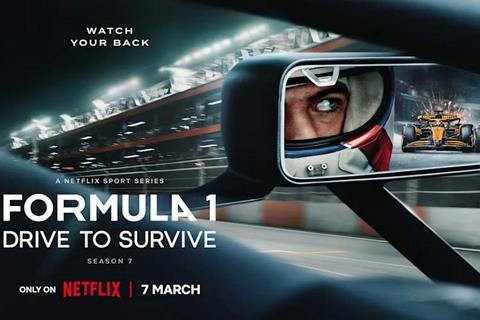Finite Films & TV founder Amy Gardner looks at what could be next for sport documentaries

When Drive To Survive debuted in 2019 it took Formula 1 mainstream and with it, redefined sports storytelling. Through dramatic editing, behind-the-scenes access and an epic scale borrowed from high end drama, Netflix turned F1 into a global obsession with both male and female audiences, which for a sport with very few visible women in it, was incredible.
It didn’t take long for the format to spread. Break Point did it for tennis. Full Swing tried it with golf, Unchained pedalled the same idea into cycling.
The thinking was that if it worked for F1 it could work anywhere. Every sport wanted that same chance to build new massive fanbases and rake in the cash from ad revenue, sponsorship and big TV deals.
But five years in, the magic is wearing off. The template is starting to feel a little tired and audiences are wising up to the more cynical elements of the sports using them as marketing ploys.
The law of diminishing returns
For a while, the formula was bulletproof: turn sports into character drama, frame rivalries like the political scheming of Game of Thrones, and create heroes and villains out of the athletes. It felt fresh. Until it didn’t.
Viewership hasn’t collapsed (yet) but engagement is not what it was. Series six of Drive to Survive came and went with less cultural impact than any before it – it doesn’t have that water cooler moment impact anymore.
Meanwhile, spin-offs have struggled to find the same traction. Netflix hasn’t renewed its contracts for its Rugby doc series Six Nations: Full Contact, or its Tour De France series Unchained.
Even within the sports themselves scepticism is growing.
Tennis players including Daniil Medvedev and Nick Kyrgios have criticized Break Point for going too far with artificial narrative and forced conflict that feels more at home in Married at First Sight than it does in a sports doc. Netflix didn’t commission a new season after its second, due to poor viewership, challenges securing and engaging top players, as well as struggling to resonate with the audience.
For audiences it can start to feel like déjà vu with all of them. The money being thrown at the shows means the access is good and the visuals are inevitably slick, but fans are more discerning. They’re much more switched on to the format, the intentions of the sports and brands, and whether they are being manipulated.
The bigger issue? The format confuses access with authenticity. Audiences in a post-Last Dance world are increasingly demanding the latter.
The shift to authenticity over drama
There’s a noticeable shift. Where once dramatised docuseries dominated, now the pendulum is swinging back toward realistic filmmaking and athlete-led storytelling.
Federer: Twelve Final Days takes a meditative look at the end of the career of one of the biggest sports stars to ever exist. Carlos Alcaraz: My Way, the new docuseries produced by the Spanish Morena Films for Netflix, shows there is also an interest in exploring non-American markets. Netflix’s The Last Cup, chronicling Messi’s emotional final World Cup, points to a hunger for something more grounded.
These aren’t adrenaline hits. There’s less conflict. Nor are there crashes and explosions. Instead, they’re more like personal essays told through film.
The key appears to be to focus on emotional heft. Access isn’t enough. People want to see the vulnerability. To feel like they are seeing the humans and can connect.
Even player-produced content, which has long been viewed as sanitised PR, has matured.
Tom Brady’s Man in the Arena and LeBron James’ The Shop now sit alongside traditionally produced docs as part of the landscape. They may lack journalistic distance, but they offer something else: an authored voice from within the game, unmediated.
Audiences want deeper connection rather than to binge another series and simply consume more content. They want to see behind the curtain and not find it’s just another stage.
A shift is coming
For streaming platforms, this is a reckoning moment.
There is still interest in sports spin off content. But the creative direction is changing. The days of applying the Drive to Survive formula across every league and changing room is coming to an end. The dial is moving to uncovering new narratives within particular mainstream sports, through into the non-mainstream like watersports and upcoming territories without major global celebrity athletes.
Amazon’s All Or Nothing series, once heavy on locker room machismo and tactical walkthroughs, has started looking at more human themes of burnout and mental health. Meanwhile ESPN’s 30 for 30, which was never formulaic to begin with, is seeing a quiet resurgence among viewers looking for longform, nuanced storytelling.
And while big productions dominate the algorithm, some of the most promising work is emerging from the margins, notably indie projects focused on overlooked communities and underreported sports. Great examples of this type of film are Wade in the Water, a doc on Black surfers, and Offside Dreams, about women’s footballers in Iran. They’re films with smaller budgets but a deep resonance.
These films also aren’t just relying on the traditional broadcast and distribution routes.
They’re finding their own audiences and building them on digital platforms, working with brands in a more authentic way. Our own Wings and Waves series is about the world of kiteboarding and wingfoiling – a sport many typically only encounter at the Olympics. But there is a huge and growing audience with a loyal fanbase of viewers and participants.
Going via YouTube to launch our format makes sense to engage this demographic and gives us with our brand partner North Sails the creative freedom to make the show windsurfing fans want to see.
What’s next?
Sports documentaries aren’t going away. But expectations have started to shift as the possibilities lean into the endless and content becomes increasingly transmedia and multiscreen.
The next wave will likely prioritise complexity over caricature. It’ll focus on bringing depth and choice over dramatisation.
We’ll still see elite athletes performing at the highest levels and for the highest stakes. But viewers have come to realise that the best stories don’t need to fake the tension. There’s already plenty of drama in sports, people want the human side to go with it.
It’s what made the first season of Drive To Survive so successful. It focused on the lesser known drivers as the producers couldn’t get access to Ferrari or Mercedes. Of course, that all changed once they saw how popular the series was and the Ferraris of the world wanted a piece of the action.
Something will come and have the same massive moment as Drive to Survive – but it won’t follow the same formula.
Expect something more intimate. More human.

Amy Gardner is founder of Finite Films & TV








No comments yet